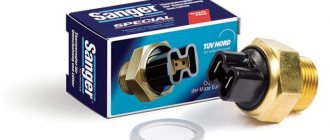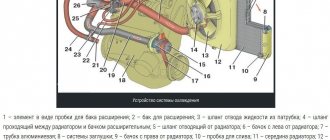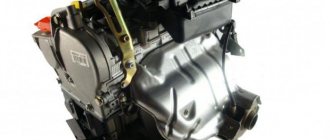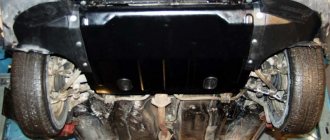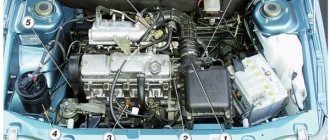A car engine is equipped with a cooling system that contains liquid. The temperature of this liquid is measured by a sensor. This value that it records is the engine operating temperature (ERT). The data recorded by the sensor is displayed on the dashboard. The average operating temperature of a Priora car engine is 95 degrees. This indicator is optimal when the car is moving at a speed of approximately 70-80 km/h and provided that the ambient temperature is not higher than +20 degrees. When the liquid heats up to 100 degrees, the fan turns on, which is designed for additional cooling. With such indicators, it is time to say that the power plant of the machine is functioning without failures. In winter and summer, the RTD may be different. Which RTD is considered optimal for this car? The average is 85-90 degrees.
Operating temperature of VAZ 21126 Priora engines
Not only the engine life, but also a number of other performance indicators depend on the operating temperature of the VAZ 21126 gasoline injection 16-valve engine. When the operating temperature is lower or higher than the nominal one, power and dynamics are lost; the temperature affects the operation of the heater and the quality of mixture formation. And this entails indicators on fuel consumption and engine life as a whole. Today we will figure out how to change the operating temperature of the Priora, Tens and Kalina 16 valve engine, what temperature is normal and how the cooling system fan affects engine operation.
Factors affecting the service life of the VAZ 2170
According to the manufacturer, the ICE 21126 with sixteen valves has a stable operation duration of 200 thousand kilometers. After a certain mileage it is necessary to carry out major repairs. Taking good care of the VAZ 2170, proper maintenance (MOT) and timely replacement of damaged components and parts will lead to a long service life of the vehicle.
Reasons affecting the service life of the power unit:
- Engine overheating. Elevated temperatures of a running engine negatively affect the overall service life of the motor. Maintaining the operating temperature of the power unit elements at a constant level significantly extends its operating time.
- Fuel. The vehicle's owner's manual contains detailed information about the recommended brand of gasoline. Filling the 16-valve Priora engine with fuel must be of proven quality.
- Machine oils. Which oil is best to fill, its brand and how much lubricant is needed is indicated in the accompanying documentation for the car. The 126 sixteen valve engine accepts semi-synthetic and synthetic motor oils most well. A complete oil change should be carried out annually or after a mileage of 15 thousand kilometers.
The optimal operating engine temperature is 90 - 95 °C. The rules allow the power unit to operate at temperatures reaching up to one hundred degrees, provided that the radiator fan is running. The engine temperature is considered low if it is below +90°C. In cold weather, it takes more time to warm up the engine to the desired mark on the device.
When servicing your VAZ 2107 car, the car owner can change the oil with his own hands. To do this, you need to know how to drain used lubricating fluid, what kind of oil to pour into the Priora and how much engine oil to pour into the neck.
Rated operating temperature of the VAZ 21126 Priora engine
Temperature sensor Lada Priora
This contributes to the normal correct operation of the power system, maximum engine performance, and in addition, the content of harmful substances in the exhaust gases complies with Euro3 standards that were current at that time. And the engine power, as practice shows, remains within the nameplate limits - about 98 forces at 5.5-5.6 thousand rpm. Again, judging by the reviews, and based on practice, fuel consumption during overheating can increase by 15-25%, and when operating the engine at coolant temperatures below 85 degrees, consumption increases by 10-18%.
Engine disassembly and repair
Repairs are carried out according to the standard procedure - we find faulty parts and replace them with working ones. The instructions below describe the process of disassembling the unit itself; before that, you need to dismantle it from the Lada Priora and thoroughly clean it of grease and dirt.
Instructions
- Using the 13th key, remove the bracket fastenings. 4 nuts hold the front cylinder block support;
- We remove the bracket and move on to the left support - it is removed in exactly the same way;
- Next, unit number 126 must be installed on the stand;
- After fixing, you can dismantle the pump cover, generator, oil pump and other external components;
- Depending on the breakdown, at this stage it is possible to replace certain components;
- Using the “tenth” key, we unscrew the fastenings of the heater tubes that go to the pump body. After this, the tube can be removed;
- Now we have access to the antifreeze pump - unscrew it from the cylinder block;
- After dismantling the pump along with the gasket, we move on to the crankshaft rear oil seal cover;
- Next, remove the bracket. Before unscrewing the connecting rod cap, you must make sure that the first piston is at bottom dead center;
- By pushing the piston into the cylinder, you can remove the piston along with the connecting rod. The pistons are removed from other cylinders in the same way;
- If necessary, you can repair the piston, namely, replace the compression and oil scraper rings along with the expander;
- The piston pin can be knocked out only after the piston is securely fixed. Place it in a vice and give it a few blows with a hammer. We recommend marking the working parts of the unit so as not to get confused while repairs are being carried out;
- To remove the crankshaft, you will need to remove its bearings and then remove the beds. Repair and assembly are carried out in the reverse order.
Thus, you can completely disassemble the 16-valve engine and repair and replace faulty parts. But if the unit bends the valve, then only an experienced mechanic can handle the malfunction with his own hands. In any case, you will find out whether the motor bends the valves or not after removing the head cover.
When does the fan turn on on a VAZ 21126 and how does it affect engine performance?
Since the VAZ 21126 engine differs only slightly from the main VAZ 2110 (21124) engine, their operating temperature conditions are the same, this applies to all 16-valve VAZ engines. Another thing is that the driver in real time can assess the operating temperature conditions only by two indicators, and even then they are not very objective - this is the arrow of the liquid temperature indicator on the instrument panel and the moment the cooling system fan turns on.
Obviously, you can’t tell much by looking at the arrow; its readings are more of a symbolic nature. But the fan on Priora and VAZ 2110 operates at a clearly set coolant temperature. The fact is that the engine control system (ECM) has more accurate temperature data than the driver. These are sensors located in the cylinder block, there are two of them.
One performs a purely decorative function and is responsible for reading the temperature indicator on the tidy. The second one is the main one. Visually, it differs in that two wires are connected to it, rather than one, and it is this wire that reports the actual antifreeze temperature to the ECM. It gives the unit accurate information and sends a command to turn on the fan.
At the same time, the engine temperature drops by an average of 5-7 degrees if the Carlson is turned on at half power, and if with full load, the temperature levels out from 105-107 ˚C to a nominal 96-98 degrees, depending on the speed and temperature outside.
Engine disassembly and repair
What is the operating temperature of the 8 valve Lada Granta engine?
Repairs are carried out according to the standard scheme - we find faulty parts and replace them with working ones. The instructions below describe the process of disassembling the unit itself; before that, you need to dismantle it from the Lada Priora and thoroughly clean it of grease and dirt.
Instructions
- Using the 13th key, remove the bracket fastenings. 4 nuts hold the front cylinder block support;
- We remove the bracket and move on to the left support - it is removed in exactly the same way;
- Next, unit number 126 must be installed on the stand;
- After fixing, you can dismantle the pump cover, generator, oil pump and other external components;
- Depending on the breakdown, at this stage it is possible to replace certain components;
- Using the “tenth” key, we unscrew the fastenings of the heater tubes that go to the pump body. After this, the tube can be removed;
- Now we have access to the antifreeze pump - unscrew it from the cylinder block;
- After dismantling the pump along with the gasket, we move on to the crankshaft rear oil seal cover;
- Next, remove the bracket. Before unscrewing the connecting rod cap, you must make sure that the first piston is at bottom dead center;
- By pushing the piston into the cylinder, you can remove the piston along with the connecting rod. The pistons are removed from other cylinders in the same way;
- If necessary, you can repair the piston, namely, replace the compression and oil scraper rings along with the expander;
- The piston pin can be knocked out only after the piston is securely fixed. Place it in a vice and give it a few blows with a hammer. We recommend marking the working parts of the unit so as not to get confused while repairs are being carried out;
- To remove the crankshaft, you will need to remove its bearings and then remove the beds. Repair and assembly are carried out in the reverse order.
Thus, you can completely disassemble the 16-valve engine and repair and replace faulty parts. But if the unit bends the valve, then only an experienced mechanic can handle the malfunction with his own hands. In any case, you will find out whether the motor bends the valves or not after removing the head cover.
Select VAZ engine model
What is the operating temperature of a Priora 16 valve engine?
Not only the engine life, but also a number of other performance indicators depend on the operating temperature of the VAZ 21126 gasoline injection 16-valve engine. When the operating temperature is lower or higher than the nominal one, power and dynamics are lost; the temperature affects the operation of the heater and the quality of mixture formation. And this entails indicators on fuel consumption and engine life as a whole. Today we will figure out how to change the operating temperature of the Priora, Tens and Kalina 16 valve engine, what temperature is normal and how the cooling system fan affects engine operation.
Why does the engine stall?
Frequently encountered breakdowns of this power unit include such defects as unstable operation and engine tripping. Such failures occur due to malfunctions in engine components and parts:
- decrease in fuel pressure;
- defects in gas distribution mechanism elements;
- sensor malfunctions;
- violation of tightness in hoses;
- faulty throttle valve.
The power of the power unit is reduced for the following reasons:
- low compression in one or more cylinders;
- burnout of gaskets;
- wear of cylinder walls;
- erasing piston rings;
- deformation of pistons under the influence of high temperatures.
Engine friction can be eliminated by flushing the injectors. The reasons for unstable operation of the power unit may lie in the malfunction of the following devices:
- spark plugs for Priora 16 valves;
- ignition coil;
- throttle valve;
- idle air control;
- battery;
- starter;
- ignition coil;
- gasoline pump;
- fuel filter;
- fuel pressure regulating device.
You can replace the spark plugs on Priora yourself. To do this, you need to familiarize yourself with the principles of correct selection and replacement of these nodes, described in special articles on the Internet.
Rated operating temperature of the VAZ 21126 Priora engine
To find out what the normal operating temperature is in the Priora 16 class injection engine, just study the factory technical documentation. It says that according to the International Motor Vehicle Manufacturers Convention, the operating temperature in gasoline engines with an injection power system should be within 90 degrees. VAZ 21126 engine must operate in the temperature range from 87 to 103 degrees .
Temperature sensor Lada Priora
This contributes to the normal correct operation of the power system, maximum engine performance, and in addition, the content of harmful substances in the exhaust gases complies with Euro3 standards that were current at that time. And the engine power, as practice shows, remains within the nameplate limits - about 98 forces at 5.5-5.6 thousand rpm. Again, judging by the reviews, and based on practice, fuel consumption during overheating can increase by 15-25%, and when operating the engine at coolant temperatures below 85 degrees, consumption increases by 10-18%.
Work resource
The manufacturer states that the 126 by 16 valve engine can operate stably for 200 thousand kilometers. After this limit, the power plant requires major overhaul. But do not forget that AvtoVAZ is a real lottery; for some Priora owners, the engine caught a wedge at 2 thousand. But if you take care of your Lada car, regularly perform maintenance and replace damaged components, then you can safely count on a service life of 150-200 thousand km.
The resource of the power plant is influenced by many factors, here are some of them:
- Overheating . Running the engine on a Priora at elevated temperatures significantly reduces its service life. The operating temperature, which we will talk about in the next section, must be maintained at the same level.
- Fuel . The instruction manual indicates what kind of gasoline should be poured into engine number 126 with 16 valves. It is also recommended to visit only trusted gas stations that will not fill you with diluted fuel.
- Engine oil . Everything is simple here - change the lubricant in a timely manner and buy high-quality oils, then the service life will be 150-200 thousand km. For the 16 valve unit 126, semi-synthetics (Lada recommendation) and synthetics are suitable. The oil needs to be changed once a year or every 15 thousand kilometers; as you can see, the fluid does not have a long service life.
Priora temperature sensor. How to check
Consequently, all responsibility for turning on the fan, and, consequently, adjusting the operating temperature, lies with the sensor. Its design is simple. This is an ordinary temperature sensor, which, when the temperature changes, changes the strength of the supplied response pulse. This is what the characteristics of the engine temperature sensor for VAZ 21126 Priora and Kalina look like:
Liquid temperature, °C
Naturally, as the temperature changes, the sensor voltage will also change.
Liquid temperature, °C
Method for checking the fan switching temperature sensor of Priora, Kalina, VAZ 2110
Therefore, if you have a multimeter in your hands and some skills in working with it, you can easily check the temperature sensor. To do this, you need to know to what temperature it is heated (which is easy to find out with a simple thermometer), and take the readings of a multimeter. Now the question of how to find out the temperature at which the fan turns on on Priora, Kalina and VAZ 2110 with a 16-valve VAZ 21126 engine disappears, and you can also draw a simple conclusion.
Once the antifreeze temperature reaches 110˚C, the sensor resistance is about 133 ohms. At the same time, the ECM sends a signal to turn on the fan. When the sensor resistance is about 188 Ohms at a temperature of 97-98 °C, the fan automatically turns off.
Schematic diagram of connecting the fan switch sensor
Thus, we have found out the principle of operation of the cooling system fan of Priora and Kalina cars with a 16-valve VAZ 21126 engine, as well as indications of the normal temperature in the cooling system.
A car engine is equipped with a cooling system that contains liquid. The temperature of this liquid is measured by a sensor. This value that it records is the engine operating temperature (ERT). The data recorded by the sensor is displayed on the dashboard. The average operating temperature of a Priora car engine is 95 degrees. This indicator is optimal when the car is moving at a speed of approximately 70-80 km/h and provided that the ambient temperature is not higher than +20 degrees. When the liquid heats up to 100 degrees, the fan turns on, which is designed for additional cooling. With such indicators, it is time to say that the power plant of the machine is functioning without failures. In winter and summer, the RTD may be different. Which RTD is considered optimal for this car? The average is 85-90 degrees.
Refinement of the cooling system
Domestic cars are far from perfect, that's a fact. Lada Priora was no exception in this regard, having inherited many shortcomings from the legendary “ten”. One of them is an unfinished cooling system.
There are several ways to quickly and without financial costs modify the SOD on Priora.
- Installing a 6-hole thermostat (stable maintenance of coolant temperature).
- The use of Kalina SOD on Priora will reduce the pressure in the system and provide quick warm-up at subzero temperatures.
- Installing a larger or additional water pump to improve coolant circulation efficiency.
- Use of multi-speed and silent forced cooling fan.
- Changing the firmware of the control unit so that the fan operates at a lower temperature.
Refining the cooling system of the Lada Priora is a feasible task even for novice car enthusiasts. The SOD has a simple design with a minimal set of components. Thanks to this, the system is relatively reliable.
If the operating rules are followed, the ODS does not cause problems for the car owner, but natural wear of parts is possible. Therefore, it is necessary to regularly monitor the operation of the system and, if even minor problems are identified, correct them as soon as possible.
The VAZ 2170 model received several power plants, but the most popular engine in the Priora is a gasoline unit with 16 valves and a volume of 1.6 liters. On various automotive forums it is called briefly - 126 (number). Responsible drivers spend a long time thinking about which car to buy, and the engine plays an important role in this matter. Service life, operating temperature, price of a new motor, analysis - our review will answer all these questions.
If the fan does not turn on
If the RTD has risen to 100 degrees and the indicator needle has entered the red part of the scale, this indicates overheating. Perhaps this phenomenon occurred due to the fact that the fan did not work. If you find that when it overheats, the fan does not start working and the temperature does not drop, you need to check the serviceability of the fan itself. It is necessary to determine whether the switch-on sensor is triggered when the normal RTD is exceeded? First, start the engine and disconnect the wires from the temperature sensor that is installed on the engine. When the wires are disconnected, forced cooling should work. If this does not happen, most likely the fault lies in the electric motor of the device. How to check the operation of the fan, watch the video.
If the fan turns on after disconnecting the wires, it means there is a problem with the fan switch sensor. Perhaps it incorrectly perceives data about the RTD and therefore does not operate at the right time.
This malfunction is quite easy to fix: you just need to replace the sensor. After replacing it, check if the fan turns on. To do this, start the engine. When the RTD reaches normal levels, do not turn off the engine until the temperature exceeds the norm. As soon as this happens, the fan should be activated. If the fan operates at a temperature above 97 degrees, but less than 100 degrees, then the system is functioning properly.
Are the valves bent?
Each engine in a Lada Priora car bends a valve, this also applies to the most powerful unit number 126 by 16. They will tell you this in any service center that services domestic cars. But novice drivers should know that the engine bends components for a reason, and if you follow the operating rules, you will not encounter this problem.
The Lada power plant bends parts only if the routine work to replace the belt and other components of the gas distribution mechanism (GRM) is violated. The motor bends the valve if the rollers, belt or water pump were not replaced in time. When one of these elements breaks, the number 126 pistons meet the valves. Due to this design feature, the motor bends the parts. The solution to the problem is a major overhaul of the Lada.
see also
So, the task of the owner of a Lada Priora with engine number 126 for 16 cl is to check the timing belt in a timely manner.
The condition of the belt should be checked every 50 thousand kilometers (according to the factory recommendations - 100 thousand) - there should be no cracks, delaminations, or breaks on it. If they are present, the belt must be changed urgently. Mandatory repairs take place after 200 thousand kilometers.
The rollers and timing pump number 126 should also be given attention when inspecting the belt. After all, the engine bends parts even with faulty rollers. Sometimes the timing belt and its components wear out prematurely - you will know this by vibrations from the engine compartment and an unpleasant grinding noise. Engine number 126 bends the valve, so do not forget to change the timing components in time and repair this unit.
Temperature sensor malfunction
The reason that the liquid in the cooling system, which serves as an air conditioner for the car's power plant, does not heat up or overheats is due to the failure of the temperature sensor.
Often signs of such a malfunction are:
Many drivers quickly stop the car when it overheats and turn off the engine. In fact, an immediate stop of the machine is required only if the tightness of the system is broken and liquid pours out of it
out. In other situations, the driver must perform the following actions:
Features of cooling system malfunctions
The efficiency of the structure primarily depends on the level of antifreeze in the system and its condition (this liquid has a certain resource, usually up to three years or up to 50,000 km). The main sources of system malfunctions are the thermostat, radiator and electric fan, as well as the water pump, the principle of operation of which is described above.
The radiator most often becomes the source of antifreeze leakage. Accordingly, the liquid level in the system drops, and there is not enough of it for effective heat removal. The motor begins to overheat. It can also be clogged with garbage. And if water is used instead of antifreeze the old fashioned way, scale may form.
DTOZH for the pointer on the instrument panel
The operating principle of this sensor is to change the resistance when the internal element heats up. Passing through the indicator on the instrument panel, the current flows through a single wire to the device. And here the principle of induction in coils comes into play. Simply put, the higher the resistance, the more the needle on the indicator rises, due to the circulating currents in the coil located inside the indicator.
Possible malfunctions of the Priora coolant temperature display system
Most motorists, having discovered that the engine temperature gauge needle does not rise, believe that it is necessary to change the sensor. However, you should first make sure that this is the case. After all, there are several reasons for this state of the panel:
Therefore, it is better to conduct a small check on your own.
Location and serviceability check of DTOZH
This device is located directly above the Priora flywheel housing. The sensor is embedded in the engine block near the thermostat. It is connected to a single wire with a female connector. The test method for this device is very simple. And it has been used by drivers for a very long time. You need to do this:
If the DTOZH itself is faulty, the indicator arrow will rise to its highest position. But if no changes occur on the instrument panel, then the reason must be looked for elsewhere. Maybe the circuit is broken, the pointer is broken, or the whole combination.
How to replace the Priora coolant temperature sensor
This is a fairly simple operation. It is available to any driver.
Important! Many believe that this requires draining the coolant. But this is not necessary if you act quickly and skillfully. Otherwise, it’s better to drain it anyway. So. Just in case, drain the antifreeze. To do this, unscrew the cap in the radiator. It is located near the generator, below. And a plug-bolt in the engine block. First place the container under the bottom.
Lada Priora (2019). Engine temperature drops while driving
If the thermostat cannot close all the way, allowing the fluid to continuously circulate in a large circle, the engine will not warm up to its operating temperature.
Sometimes the thermostat gets stuck after the engine has warmed up. When this happens, the driver may notice that the engine temperature drops while driving, although it should be maintained at a consistently even, operating level.
Sometimes the temperature regime changes abruptly, sometimes increases, sometimes decreases sharply. This means that the valve periodically jams, and the driver will notice a situation where the temperature arrow periodically drops.
There are other technical reasons that affect the underheating of a car’s power unit:
Fan malfunction. This electrical element should turn on only when the control unit gives it a special command based on the readings of temperature sensors. Failures in the coordinated operation of the system can lead to the fan operating in constant mode, or starting to function even when it is not necessary. Sometimes even the sensor turns out to have nothing to do with it, and the rotation of the blades causes a normal wiring short circuit. Problems with viscous couplings are also common. They are typical for models that have a longitudinally mounted motor, the fan of which bases its operation on a special device - an electronic clutch. Its jamming will not allow the element to turn off, and the car engine will not be able to warm up to operating levels.
While driving, the temperature needle drops. Natural causes
Yes, this option is also allowed by specialized specialists. Even if there are no malfunctions in the operation of the vehicle systems, the indicator needle may still fall while driving. Similar situations occur in winter, when the air temperature drops to low values. For example, when driving on country roads in severe frost, the driver may notice significant cooling of the engine. The fact is that the flow of icy air entering the engine compartment can exceed the heating intensity of the engine. At an average speed of 90-100 km/h, which is optimal for most car models, a minimum amount of fuel burns inside the cylinders.
The relationship between these factors is direct: the less fuel ignites in the combustion chambers, the slower the internal combustion engine will warm up. If we add to this the forced cooling that occurs from the oncoming air flow, the engine may not only not heat up, but even significantly reduce its temperature in the event of preheating.
How does the heater affect the engine temperature gauge?
The inclusion and constant operation of the cabin heater has no less a strong impact than malfunctions or frost. It is especially noticeable on small cars and models equipped with medium-sized engines. The situation is also typical for diesel engines, which not only do not warm up well at idle, but also cool down quickly when driving with insufficient intensity.
The car heater has a special radiator, which is included in the general operating circuit of the cooling system. When the driver turns on the interior heating, antifreeze passes through it, giving off some of the heat. The amount that will be given depends on the set temperature of the heater and its operating mode. The higher these indicators are, the more the interior of the car will heat up. If the engine operates at low speeds, and is also used in winter, there may simply not be enough heat to fully warm up the coolant. In such a situation, the engine will not reach its operating temperature.
Flushing the cooling system of Lada Priora
It becomes dirty and clogged over time and intensity of use. Clogged SOD channels do not allow antifreeze to circulate freely, as a result, heat transfer is disrupted. The stove in the cabin begins to heat poorly, and meanwhile the engine constantly overheats. In these situations, the right solution would be to clean the cooling system. To do this, first of all you need to cool the engine.
The following is the procedure.
- Drain the coolant (not only from the radiator, but also from the engine jacket, by unscrewing the drain plug on the cylinder block).
- Fill the expansion tank with any suitable flushing fluid to the optimum level.
- Start the engine and let it idle for at least 15 minutes.
- Drain the used fluid.
Then, if necessary, the procedure is repeated. After flushing, all that remains is to fill in fresh antifreeze and remove the air lock from the system. If a more thorough flushing of the system is required, then there is nothing complicated here either. To do this, you will need a regular watering hose connected to the water supply. To flush the radiator, you need to disconnect the lower and upper pipes, insert them into the upper hose and turn on the water. All dirt and rust will come out of the bottom. To flush the engine jacket, you need to do the same steps, but the hose is inserted into the thermostat pipe.
The effectiveness of flushing the system largely depends on the product chosen as a flushing agent.
The simplest option is regular tap water. Add lemon juice to it. Carbonated drinks, such as cola, are also suitable. You can also buy special cleaning products for washing SOD in specialized stores.
Characteristics and features of DTOZH on Priora
Many motorists confuse the DTOZH with a cabin or ambient temperature sensor, but this is completely wrong. The purpose of the DTOZH is to monitor the temperature of the refrigerant in the cooling system.
There are two regulators in Lada Priora cars:
As for the principle of operation, it is as follows. The main regulator is located in the thermostat housing, which allows for the highest pulse accuracy. Since the DTOZH in any case comes into contact with consumables, that is, antifreeze, it instantly detects changes in temperature and sends corresponding signals to the ECU. The latter, based on the information received, adjusts the operation of the engine and changes the composition of the air-fuel mixture. If there is no or too low level of consumable fluid in the system, the controller will provide incorrect data.
DIY replacement instructions
If the diagnostics showed that the DTOZH is operational, but signs of a malfunction still appear, then, as we have already said, check the quality of the regulator connection and wiring. If, as a result of the check, it turns out that the device is inoperative, then the coolant temperature sensor will need to be replaced. The replacement procedure itself is not particularly complicated; even a novice car enthusiast can handle it.
As you know, Lada Priora cars go on sale in several modifications - with an 8 or 16 valve engine. Therefore, some car owners may think that the replacement procedure will look different in both cases. But we immediately want to dispel doubts - everything will look almost identical - the thermostat housing is located in the same place on both versions of the engine. The only difference is that you will need to dismantle the line that connects the air filter element to the throttle in advance.
When does the fan turn on on a VAZ 21126 and how does it affect engine performance?
Since the VAZ 21126 engine differs only slightly from the main VAZ 2110 (21124) engine, their operating temperature conditions are the same, this applies to all 16-valve VAZ engines. Another thing is that the driver in real time can assess the operating temperature conditions only by two indicators, and even then they are not very objective - this is the arrow of the liquid temperature indicator on the instrument panel and the moment the cooling system fan turns on.
Location of the temperature sensor, this sensor only works on the indicator on the dashboard
Obviously, you can’t tell much by looking at the arrow; its readings are more of a symbolic nature. But the fan on Priora and VAZ 2110 operates at a clearly set coolant temperature. The fact is that the engine control system (ECM) has more accurate temperature data than the driver. These are sensors located in the cylinder block, there are two of them.
One performs a purely decorative function and is responsible for reading the temperature indicator on the tidy. The second one is the main one. Visually, it differs in that two wires are connected to it, rather than one, and it is this wire that reports the actual antifreeze temperature to the ECM. It gives the unit accurate information and sends a command to turn on the fan.
The fan switch sensor is located near the thermostat, above the temperature indicator sensor
At the same time, the engine temperature drops by an average of 5-7 degrees if the Carlson is turned on at half power, and if with full load, the temperature levels out from 105-107 ˚C to a nominal 96-98 degrees, depending on the speed and temperature outside.
Choosing new thermostats for cars
Operating temperature of the VAZ-2114 engine 8 valves: facts
Since the cost of a thermostat is usually not very high, and it is responsible for the performance of an expensive engine, it is better to change it every two years. Today you can find several types of such devices on the specialized market. The most primitive are mechanical devices. But an electronic thermostat for a car controls the temperature using a special sensor. There are also electromechanical units that operate using contact pairs.
When choosing a thermostat, it is very important to know its temperature regime, since it differs for different brands of cars. And, of course, it is necessary to select the device strictly according to this parameter
Thus, thermostats for cars can be high-temperature, operating in the range of 300–1200 °C. The valve opening for medium-temperature devices occurs in the range of 60–500 °C. There are also low-temperature devices with an operating temperature of less than 60 °C.
Coolant replacement
Note that the technology for replacing the refrigerant in versions of LADA Kalina with an 8-valve engine is somewhat different from the sequence of work on variations of 16-valve engines. In the latter case, to provide access to the block drain plug, you will need to remove the starter fasteners. And before work, we’ll find out how to drain antifreeze correctly.
Procedure for 8-valve Kalinas
- We release the pressure in the previously indicated way.
- We dismantle the crankcase protection.
- We place the prepared container under the drain hole (located on the right side of the radiator).
- You can regulate the pressure of the drained stream of liquid by tightening or removing the plug on the tank. We carry out this manipulation, focusing on the situation.
- Having unscrewed the radiator cap, we wait for the liquid to completely drain.
- Now we move to the motor block.
- The drain plug is located under the ignition coil.
- To unscrew the specified plug, we use a 13-size wrench.
- We substitute the same container and collect the remaining liquid into it.
The antifreeze replacement is complete.
Engine disassembly and repair
Repairs are carried out according to the standard procedure - we find faulty parts and replace them with working ones. The instructions below describe the process of disassembling the unit itself; before that, you need to dismantle it from the Lada Priora and thoroughly clean it of grease and dirt.
Instructions
- Using the 13th key, remove the bracket fastenings. 4 nuts hold the front cylinder block support;
- We remove the bracket and move on to the left support - it is removed in exactly the same way;
Thus, you can completely disassemble the 16-valve engine and repair and replace faulty parts. But if the unit bends the valve, then only an experienced mechanic can handle the malfunction with his own hands. In any case, you will find out whether the motor bends the valves or not after removing the head cover.
Signs of the need for internal combustion engine repair
The reasons why the operation of the engine is disrupted are arranged in a small list, starting with refusal to start and ending with floating idle speed (this problem was removed on the 127 “engine”). Not all breakdowns end in capital damage - sometimes it’s enough to add oil, sometimes it’s enough to adjust the ECU settings.
Compression reduction
A decrease in cylinder compression below 16 atmospheres is a bad sign. Such a high limit corresponds to a compression ratio of 11.
Knocks in the engine
Engine knocks can come from several points. These could be hydraulic compressors, timing belt rollers or pins. The knocking noise could also be caused by low oil level. The answer to the question will be given by a thorough detailed inspection of all parts of the unit and checking the oil level.
Blue smoke from the exhaust pipe
The blue smoke that comes from the exhaust pipe appears when oil enters the combustion chamber. It can leak either from the valves or from under the piston. The result is the same: the oil is eaten up and blue smoke pours out of the chimney. Once the leak is located, half the problem will already be solved.
Troit motor
Sometimes in the cold the engine may stall - don’t be alarmed by this, because it may simply be one of the spark plugs that fails. In this case, we advise you to simply restart the engine and it will stop running.
How much does it cost to overhaul a Priora engine - average price
Self-repair of a Priora engine with 16 valves costs an average of 16-20 thousand rubles. The cost depends on the severity of the breakdown and may be lower or higher than this average range. Repairing a Priora engine can be entrusted to the wrong hands, but then you will have to pay for the work - sometimes the cost of repairs reaches as much as 40 thousand rubles.
This is an unreasonably inflated figure, because, as practice shows, you can rebuild the engine on a Priora, working at a moderate pace, in just three days - and three days of work is definitely not worth that kind of money. Don’t be afraid of not being able to cope - your Lada is easy to repair, and using the advice and “tutorials”, you will conquer even such a task that is impossible at first glance.
